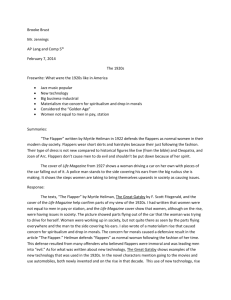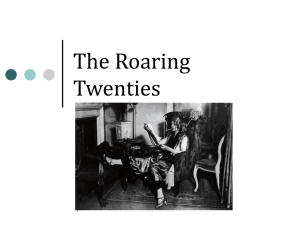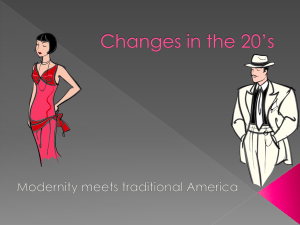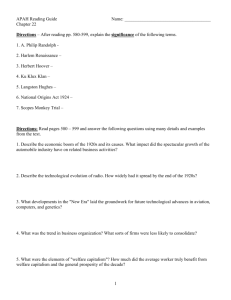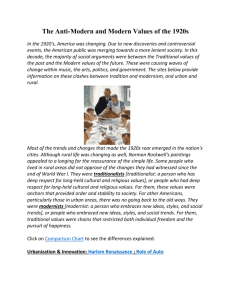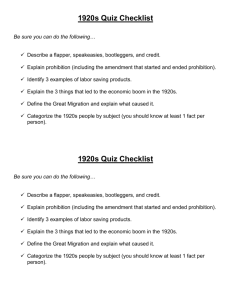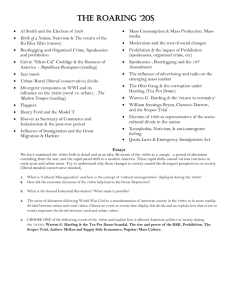New Opportunities The 19th Amendment allowed women to vote
advertisement
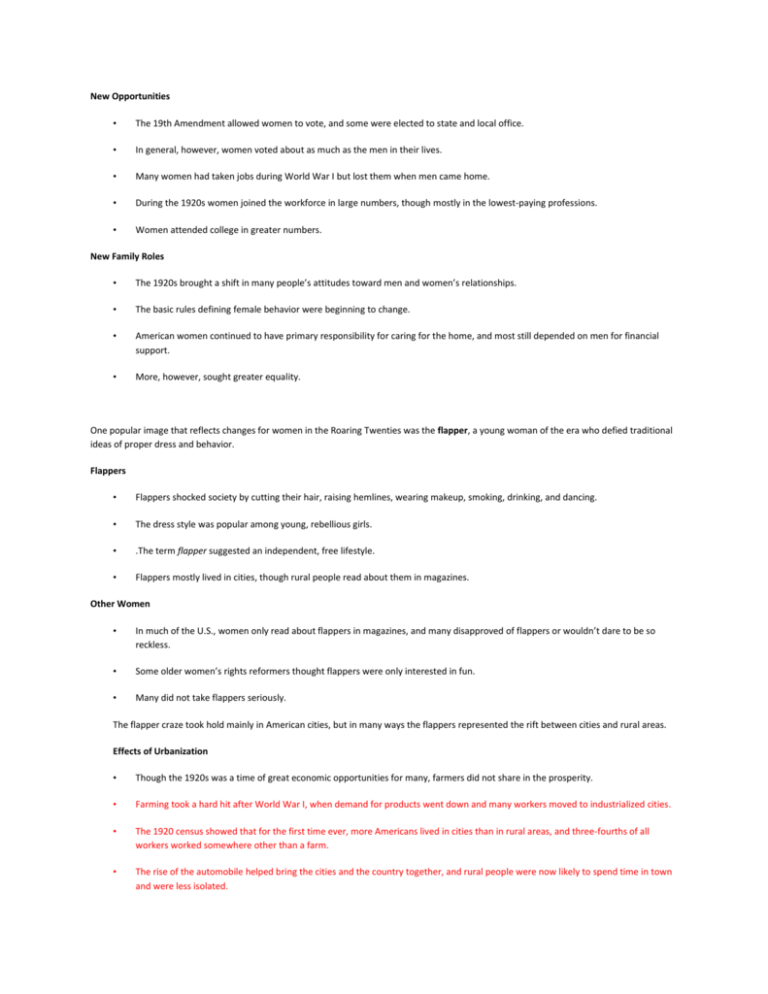
New Opportunities • The 19th Amendment allowed women to vote, and some were elected to state and local office. • In general, however, women voted about as much as the men in their lives. • Many women had taken jobs during World War I but lost them when men came home. • During the 1920s women joined the workforce in large numbers, though mostly in the lowest-paying professions. • Women attended college in greater numbers. New Family Roles • The 1920s brought a shift in many people’s attitudes toward men and women’s relationships. • The basic rules defining female behavior were beginning to change. • American women continued to have primary responsibility for caring for the home, and most still depended on men for financial support. • More, however, sought greater equality. One popular image that reflects changes for women in the Roaring Twenties was the flapper, a young woman of the era who defied traditional ideas of proper dress and behavior. Flappers • Flappers shocked society by cutting their hair, raising hemlines, wearing makeup, smoking, drinking, and dancing. • The dress style was popular among young, rebellious girls. • .The term flapper suggested an independent, free lifestyle. • Flappers mostly lived in cities, though rural people read about them in magazines. Other Women • In much of the U.S., women only read about flappers in magazines, and many disapproved of flappers or wouldn’t dare to be so reckless. • Some older women’s rights reformers thought flappers were only interested in fun. • Many did not take flappers seriously. The flapper craze took hold mainly in American cities, but in many ways the flappers represented the rift between cities and rural areas. Effects of Urbanization • Though the 1920s was a time of great economic opportunities for many, farmers did not share in the prosperity. • Farming took a hard hit after World War I, when demand for products went down and many workers moved to industrialized cities. • The 1920 census showed that for the first time ever, more Americans lived in cities than in rural areas, and three-fourths of all workers worked somewhere other than a farm. • The rise of the automobile helped bring the cities and the country together, and rural people were now likely to spend time in town and were less isolated. • Education also increased, and by the 1920s many states passed laws requiring children to attend school, helping force children out of workplaces. • School attendance and enrollment increased as industry grew because more people could afford to send their children to school, not to work. Conflicts over Values • Americans lived in larger communities, which produced a shift in values, or a person’s key beliefs and ideas. • In the 1920s, many people in urban areas had values that differed from those in rural areas. • – Rural America represented the traditional spirit of hard work, self-reliance, religion, and independence. – Cities represented changes that threatened those values. The Ku Klux Klan grew dramatically in the 1920s, and many of its members were people from rural America who saw their status declining. – Members of the Klan continued to use violence, targeting African Americans, Catholics, Jews, and all immigrants. – In the 1920s, the Klan focused on influencing politics. – The Klan’s membership was mostly in the South but spread nationwide. – The Klan’s peak membership was in the millions, many from Indiana, Illinois, and Ohio. – Membership declined in the late 1920s because of a series of scandals affecting Klan leaders. The Rise of Fundamentalism Billy Sunday • Changing times caused uncertainty, turning many to religion for answers. • One key religious figure of the time was former ballplayer and ordained minister Billy Sunday. • Sunday condemned radicals and criticized the changing attitudes of women, reflecting much of white, rural America’s ideals. • Sunday’s Christian beliefs were based on a literal translation of the Bible called fundamentalism. Aimee Semple McPherson • Another leading fundamentalist preacher of the time • Seemed to embrace the kind of glamour that other fundamentalists warned about • Her religion, however, was purely fundamentalist. • She was especially well known for healing the sick through prayer. The Scopes Trial • Charles Darwin’s theory of evolution holds that inherited characteristics of a population change over generations, which sometimes results in the rise of a new species. – According to Darwin, the human species may have evolved from an ape-like species that lived long ago. – Fundamentalists think this theory is against the biblical account of how God created humans and that teaching evolution undermine religious faith. • Fundamentalists worked to pass laws preventing evolution being taught in schools, and several states did, including Tennessee in 1925. • One group in Tennessee persuaded a young science teacher named John Scopes to violate the law, get arrested, and go to trial. • Scopes was represented by Clarence Darrow, and William Jennings Bryan, three-time candidate for president, represented the prosecution. • John Scopes was obviously guilty, but the trial was about larger issues. • Scopes was convicted and fined $100, but Darrow never got a chance to appeal because the conviction was overturned due to a technical violation by the judge. • The Tennessee law remained in place until the 1960s. Prohibition • Throughout U.S. history, groups like the Woman’s Christian Temperance Union worked to outlaw alcohol, but the drive strengthened in the early 1900s, as Progressives joined the effort. • Over the years, a number of states passed anti-alcohol laws, and World War I helped the cause when grain and grapes, which most alcohol is made from, needed to feed troops. • The fight against alcohol also used bias against immigrants to fuel their cause by portraying immigrant groups as alcoholics. • Protestant religious groups and fundamentalists also favored a liquor ban because they thought alcohol contributed to society’s evils and sins, especially in cities. • By 1917 more than half the states had passed a law restricting alcohol. • The Eighteenth Amendment banning alcohol was proposed in 1917 and ratified in 1919. The Volstead Act enforced the amendment. Prohibition in Practice • Enforcing the new Prohibition law proved to be virtually impossible, as making, transporting, and selling alcohol was illegal, but drinking it was not. • Prohibition gave rise to huge smuggling operations, as alcohol slipped into the country through states like Michigan on the Canadian border. • Newspapers followed the hunt for bootleggers, or liquor smugglers, but government officials estimated that in 1925 they caught only 5 percent of all the illegal liquor entering the country. • Many people also made their own liquor using homemade equipment, and others got alcohol from doctors, who could prescribe it as medicine. • The illegal liquor business was the foundation of great criminal empires, like Chicago gangster Al Capone’s crew, who smashed competition, then frightened and bribed police and officials. • 3,000 Prohibition agents nationwide worked to shut down speakeasies, or illegal bars, and to capture illegal liquor and stop gangsters. • Millions of Americans violated the laws, but it would be many years before Prohibition came to an end.
